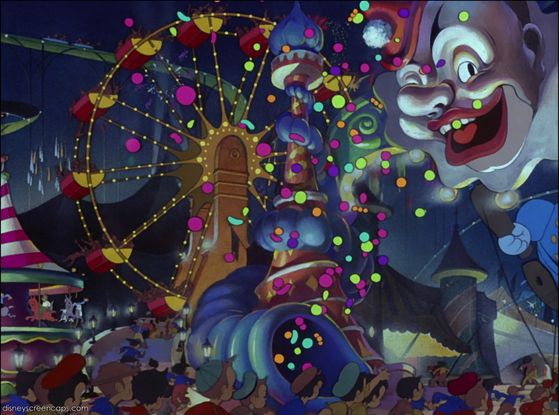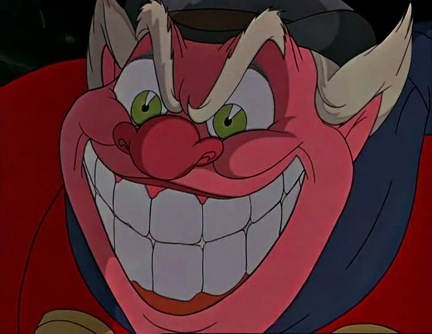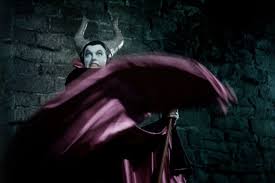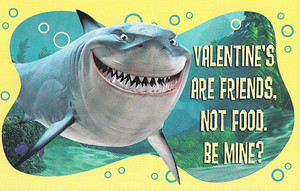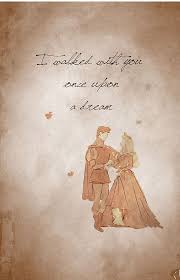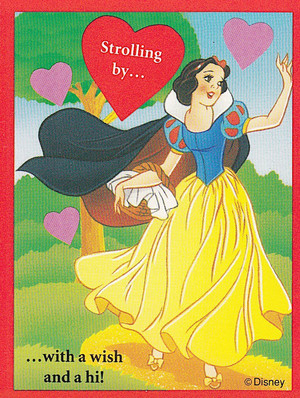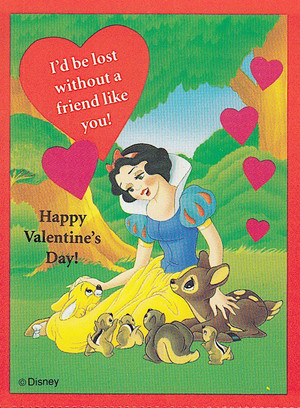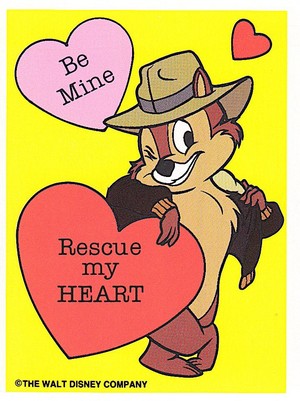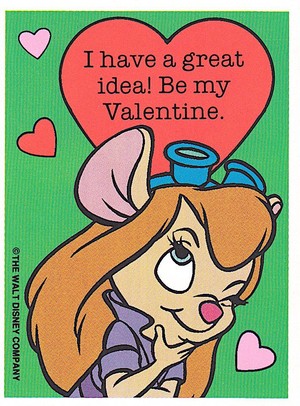Well, so far I moved back through the ages, so I guess it’s time to tackle a movie from Disney’s golden age. Pinocchio started, like a lot of classic novels, as a serials, which soon became popular and lead a novel. Nowadays it has become common to analyse Pinocchio like a book for “adults” (because, you know, children’s books don’t require analysing in the minds of serious academics, we first have to declare them as “adult” to be taken seriously), leading to the stories being read in a literature-historical contexts, with parallels drawn especially to the concept of the fool. But when Disney made the movie, it was still mostly seen as an educational book, used to teach children that bad deeds have bad consequences. This is therefore the most prominent aspect in the movie.
1. The world of Pinocchio
To be frank: The world which is created around Pinocchio is rather odd, even odder than usual in a fairy tale. There just don’t seem to be any logical rules to it, and it’s sometimes aggravating how everyone expects Pinocchio to act reasonable even though nothing about the world he lives in is reasonable (at one point he even gets arrested for the “crime of foolishness” when he goes to the police after the soro conned him out of his money). The Disney version amplifies this even more. Seeing a talking, clothed soro pagganap all surprised because he comes across a living marionette is just odd. It also doesn’t help that there seems to be no consistency to what Pinocchio can survive and what not. How he can “die” towards the end, even though he apparently can easily walk under water and has no Buto or anything else which could break is anybody’s guess.
The Disney version is also very dark. The only really inviting place in it is Gepetto’s hut, everything else is full of shadows and has a sinister vibe to it. It’s sometimes unpleasant to look it, not because of the animation is bad, but because it’s deliberately designed to be unsettling. Especially in the Pleasure Island scenes.
2. Characters and Plot
I’ll do both section in one this time around, because the plot centres around Pinocchio even madami than usual, since the main theme is his learning curve. And there is a fundamental difference between the pinagmulan text and the movie, which influences madami or less every decision Disney made regarding the characters. In the original version, Pinocchio is, in lack of a better term, born bad. He is selfish, lacks compassion and shows no appreciation for what Gepetto does for him. One early episode involves Gepetto selling his warm amerikana in order to buy school books for Pinocchio. Pinocchio in turn sells the school books so that he can see Stromboli’s marionette show. He only learns through experience to feel compassion (or care about Gepetto at all).
Disney’s Pinocchio on the other hand starts out as a blank slate. He immediately connects to Gepetto simply on the ground of him being his father and provider. And when he ends up in dangerous situations it’s not because he is selfish, but because he is gullible, easily lead astray sa pamamagitan ng dangerous advice. This change of character is also the reason Jiminy Cricket even exists. There is a Cricket in the original novel, but its appearance is very short-lived, in every sense of the world, since Pinocchio almost immediately kills it and it only turns up later in ghost form and berates him for his wrongdoings. That Disney greatly expanded the role and made Jiminy, quite literally, Pinocchio’s consciences is necessary because of the naivety they added to his character. If Jiminy weren’t there to warn him, there would be no way that we could truly fault Pinocchio for his actions. He is, after all, just a puppet, barely a araw old, so it would be madami than harsh to punish him for believing his elders. But since there is Jiminy as voice of reason, the responsibility shifts back to Pinocchio for listening to the fun payo over the trustworthy one.
Jiminy himself is, btw, a giant hypocrite. The whole movie he does nothing but preach towards Pinocchio, which would be okay, since that’s his job. But it’s a little bit grating that he himself doesn’t practice what he preaches most of the time and is often not there the very moment Pinocchio needs his payo the most (he also keeps ogling women made out of wood, which is just weird). The Blue Fairy gives him a job, new clothes, but is this enough for him? No, he also wants a ginto medal. One thing for sure, if I had to pick a role model for my children, it certainly wouldn’t be Jiminy, and if I were the Blue Fairy, I would have told him that he should be satisfied with what he gets.
Speaking of the Blue Fairy (actually the Blue Haired Fairy, but I guess blond looks madami attractive?): She is the ultimate Deus-ex-machina, in the book even madami than in the movie. There she just randomly turns up, becomes some sort of mother figure for Pinocchio and usually helps him out should he really come to the danger of dying (or to test him). In the movie her involvement is slightly better explained. In the book Gepetto just happened to create a marionette out of magic wood, in the movie the Blue Fairy spelled him alive as a reward for Gepetto. This is partly an improvement because this way the Blue Fairy’s interest in Pinocchio and her being somewhat of his mother makes madami sense. But it’s also a very strange reward, since the “happy outcome” entirely hinges on a piece of wood proving himself and not on Gepetto’s actions. Where exactly was the Blue Fairy when he was in the stomach of a whale?
And for that matter: Why is it that the only good adult person in the movie has to endure greater hardship than any of the other truly villainous adults? This is already a problem of the novel which gets amplified sa pamamagitan ng Disney’s typical black and white approach to characters. With Pinocchio it’s easy, whoever was in the hut when Pinocchio became alive is good, all the other characters are only there to lead him astray. Lampwick is a little bit of a special case, though, because while he is a “bad boy”, he actually means well with Pinocchio, looks out for him and tries to teach him his “wisdom”. Well, you could argue that he does it mostly because he likes himself in the leader role, but his “evilness” mostly consists of skipping school, smoking, drinking and destroying stuff in a house which is built for exactly this purpose. And this makes the fact that he and the other boys on Pleasure Island are the only ones who get a permanent punishment even worse (in the book he gets sold and Pinocchio finds him dying after a life full of hard work – just in case you wanted to know for sure what you only suspected).
Honest John and Gideon sell Pinocchio twice and get away with it (and the gold). Stromboli (who isn’t really a villain in the novel) holds him like a slave and gets away with it (and the gold). The kutsero turns hordes of boys into donkeys and then sells them to the salt mines, where they will have a short and painful live (and I really don’t want to know what he does with the ones who still talk). And gets away with it. For all we know his operation is still in full swing. So what exactly is the message of the movie? Don’t trust anyone but your parents, be honest as long as you are a child, but when you reach adulthood you have the power to do whatever you want?
One thing for sure: Not The Hunchback of Notre Dame, not The Black Cauldron is the darkest movie Disney ever made, this honour belongs to Pinocchio. And it is not because Disney went for the dark imaginary out of a whim, it’s because Pinocchio is a very messed up story which resulted in a very messed up movie. The truth is: Disney actually disneyfied the story considerably. At least Pinocchio doesn’t get his feet burned away because he sleeps too close to the apoy or gets hanged. The whole point in both, the novel and the movie, seems to be that whenever Pinocchio (or another boy – girls are apparently always following their parents advice) does something bad or foolish, he gets punished in the most gruesome way, and the only reason he survives long enough to see the end of the book is because he is a puppet and the blue fairy turns up whenever the situation becomes really dire (though the original serial did end with Pinocchio dying – the part with the Blue Fairy was added later for the novel, which explains why she turns up so randomly).
3. The conclusion
Yeah, I guess it should be very obviously sa pamamagitan ng now: I don’t like the book, I don’t like the movie. But if one had to make a movie about Pinocchio, it should be like the Disney version. It should display this level of careful animation and dark larawan and it should attach a nice “when you wish upon a star” message to it to soften the dark aspects a little bit. And to its credit, while very exaggerated, it does address true dangers. The people who promise teenagers a great career or lure children away from their parents with sweets, those are the predators a child is protected best from when it is aware of them. I’m not a tagahanga of using fear in child rearing, but if this movie will keep my children from going with a stranger, a week of nightmares about the kutsero might be the lesser of two evils.
1. The world of Pinocchio
To be frank: The world which is created around Pinocchio is rather odd, even odder than usual in a fairy tale. There just don’t seem to be any logical rules to it, and it’s sometimes aggravating how everyone expects Pinocchio to act reasonable even though nothing about the world he lives in is reasonable (at one point he even gets arrested for the “crime of foolishness” when he goes to the police after the soro conned him out of his money). The Disney version amplifies this even more. Seeing a talking, clothed soro pagganap all surprised because he comes across a living marionette is just odd. It also doesn’t help that there seems to be no consistency to what Pinocchio can survive and what not. How he can “die” towards the end, even though he apparently can easily walk under water and has no Buto or anything else which could break is anybody’s guess.
The Disney version is also very dark. The only really inviting place in it is Gepetto’s hut, everything else is full of shadows and has a sinister vibe to it. It’s sometimes unpleasant to look it, not because of the animation is bad, but because it’s deliberately designed to be unsettling. Especially in the Pleasure Island scenes.
2. Characters and Plot
I’ll do both section in one this time around, because the plot centres around Pinocchio even madami than usual, since the main theme is his learning curve. And there is a fundamental difference between the pinagmulan text and the movie, which influences madami or less every decision Disney made regarding the characters. In the original version, Pinocchio is, in lack of a better term, born bad. He is selfish, lacks compassion and shows no appreciation for what Gepetto does for him. One early episode involves Gepetto selling his warm amerikana in order to buy school books for Pinocchio. Pinocchio in turn sells the school books so that he can see Stromboli’s marionette show. He only learns through experience to feel compassion (or care about Gepetto at all).
Disney’s Pinocchio on the other hand starts out as a blank slate. He immediately connects to Gepetto simply on the ground of him being his father and provider. And when he ends up in dangerous situations it’s not because he is selfish, but because he is gullible, easily lead astray sa pamamagitan ng dangerous advice. This change of character is also the reason Jiminy Cricket even exists. There is a Cricket in the original novel, but its appearance is very short-lived, in every sense of the world, since Pinocchio almost immediately kills it and it only turns up later in ghost form and berates him for his wrongdoings. That Disney greatly expanded the role and made Jiminy, quite literally, Pinocchio’s consciences is necessary because of the naivety they added to his character. If Jiminy weren’t there to warn him, there would be no way that we could truly fault Pinocchio for his actions. He is, after all, just a puppet, barely a araw old, so it would be madami than harsh to punish him for believing his elders. But since there is Jiminy as voice of reason, the responsibility shifts back to Pinocchio for listening to the fun payo over the trustworthy one.
Jiminy himself is, btw, a giant hypocrite. The whole movie he does nothing but preach towards Pinocchio, which would be okay, since that’s his job. But it’s a little bit grating that he himself doesn’t practice what he preaches most of the time and is often not there the very moment Pinocchio needs his payo the most (he also keeps ogling women made out of wood, which is just weird). The Blue Fairy gives him a job, new clothes, but is this enough for him? No, he also wants a ginto medal. One thing for sure, if I had to pick a role model for my children, it certainly wouldn’t be Jiminy, and if I were the Blue Fairy, I would have told him that he should be satisfied with what he gets.
Speaking of the Blue Fairy (actually the Blue Haired Fairy, but I guess blond looks madami attractive?): She is the ultimate Deus-ex-machina, in the book even madami than in the movie. There she just randomly turns up, becomes some sort of mother figure for Pinocchio and usually helps him out should he really come to the danger of dying (or to test him). In the movie her involvement is slightly better explained. In the book Gepetto just happened to create a marionette out of magic wood, in the movie the Blue Fairy spelled him alive as a reward for Gepetto. This is partly an improvement because this way the Blue Fairy’s interest in Pinocchio and her being somewhat of his mother makes madami sense. But it’s also a very strange reward, since the “happy outcome” entirely hinges on a piece of wood proving himself and not on Gepetto’s actions. Where exactly was the Blue Fairy when he was in the stomach of a whale?
And for that matter: Why is it that the only good adult person in the movie has to endure greater hardship than any of the other truly villainous adults? This is already a problem of the novel which gets amplified sa pamamagitan ng Disney’s typical black and white approach to characters. With Pinocchio it’s easy, whoever was in the hut when Pinocchio became alive is good, all the other characters are only there to lead him astray. Lampwick is a little bit of a special case, though, because while he is a “bad boy”, he actually means well with Pinocchio, looks out for him and tries to teach him his “wisdom”. Well, you could argue that he does it mostly because he likes himself in the leader role, but his “evilness” mostly consists of skipping school, smoking, drinking and destroying stuff in a house which is built for exactly this purpose. And this makes the fact that he and the other boys on Pleasure Island are the only ones who get a permanent punishment even worse (in the book he gets sold and Pinocchio finds him dying after a life full of hard work – just in case you wanted to know for sure what you only suspected).
Honest John and Gideon sell Pinocchio twice and get away with it (and the gold). Stromboli (who isn’t really a villain in the novel) holds him like a slave and gets away with it (and the gold). The kutsero turns hordes of boys into donkeys and then sells them to the salt mines, where they will have a short and painful live (and I really don’t want to know what he does with the ones who still talk). And gets away with it. For all we know his operation is still in full swing. So what exactly is the message of the movie? Don’t trust anyone but your parents, be honest as long as you are a child, but when you reach adulthood you have the power to do whatever you want?
One thing for sure: Not The Hunchback of Notre Dame, not The Black Cauldron is the darkest movie Disney ever made, this honour belongs to Pinocchio. And it is not because Disney went for the dark imaginary out of a whim, it’s because Pinocchio is a very messed up story which resulted in a very messed up movie. The truth is: Disney actually disneyfied the story considerably. At least Pinocchio doesn’t get his feet burned away because he sleeps too close to the apoy or gets hanged. The whole point in both, the novel and the movie, seems to be that whenever Pinocchio (or another boy – girls are apparently always following their parents advice) does something bad or foolish, he gets punished in the most gruesome way, and the only reason he survives long enough to see the end of the book is because he is a puppet and the blue fairy turns up whenever the situation becomes really dire (though the original serial did end with Pinocchio dying – the part with the Blue Fairy was added later for the novel, which explains why she turns up so randomly).
3. The conclusion
Yeah, I guess it should be very obviously sa pamamagitan ng now: I don’t like the book, I don’t like the movie. But if one had to make a movie about Pinocchio, it should be like the Disney version. It should display this level of careful animation and dark larawan and it should attach a nice “when you wish upon a star” message to it to soften the dark aspects a little bit. And to its credit, while very exaggerated, it does address true dangers. The people who promise teenagers a great career or lure children away from their parents with sweets, those are the predators a child is protected best from when it is aware of them. I’m not a tagahanga of using fear in child rearing, but if this movie will keep my children from going with a stranger, a week of nightmares about the kutsero might be the lesser of two evils.


